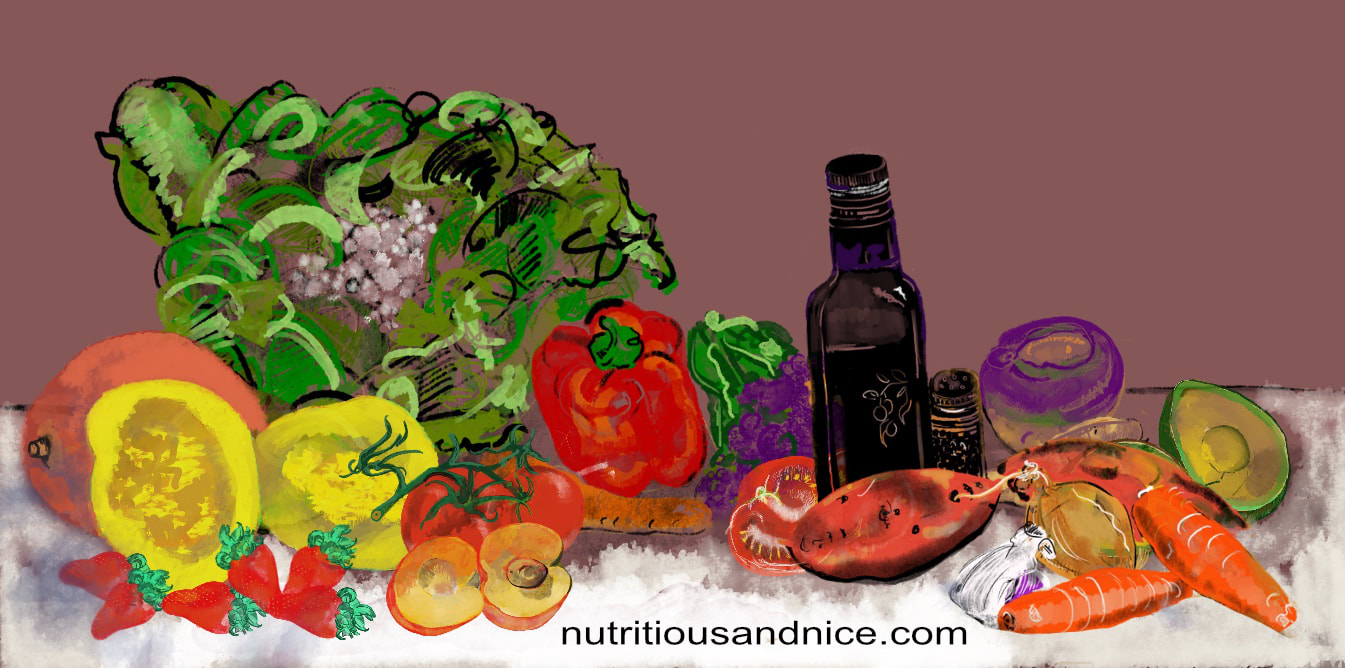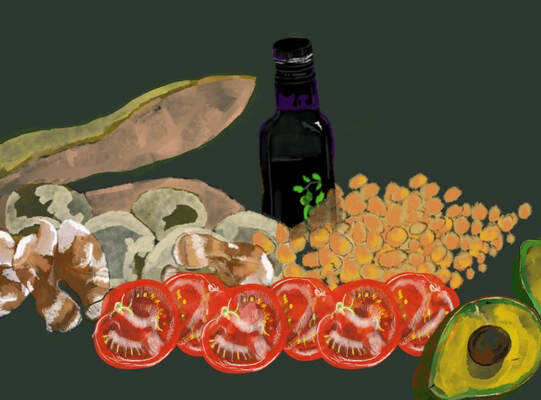NUTRITIOUSANDNICE.COM
Healing with Nutrition
|
Healing with nutrition is often a slower process than with other interventions, but the effects are more systemic, and help to maintain overall health. However good nutrition is only one aspect towards achieving a healthy state. Incorporating an holistic approach to health is beneficial. This involves; nutrition, exercise and a mindful practice. In our busy, time constricted lives, food can often be consigned to what is quick and convenient. However being mindful of what one eats is often the first step in choosing a more healthy alternative. This can also extend into the preparation of the food as well as in its consumption. That is eating without the competition of other distractions. |
Many researchers point to the beneficial impact of the traditional Mediterranean diet. This may also be attributed to the way in which the food is prepared as well as the emphasis given of eating together rather than solitary and/or distracted by other stimuli. Research can identify individual factors in foods which are more beneficial, but it is harder to measure that social component which can contribute to overall health. When looking at ones diet it is beneficial to also take into considerations those other factors.
When deciding to alter ones diet it is a good start to begin by reflecting upon the foods eaten within a wider context than just measuring calories. A good way of doing this is to keep a food diary for a week, recording what is eaten and drunk during that period. Including the time meals are eaten, snacks and drinks, and reflecting upon how the food made one feel. That is, was it enjoyable, satisfying, or did it leave one still feeling hungry shortly afterwards. It is surprising how such a simple exercise can often lead to positive changes. It would provide a very good framework for then addressing any changes that needed to be addressed.
Within traditional Chinese medicine the properties of foods are not measured as regards calories or classifications such as carbohydrates, proteins and fats. Not that these are considered as unimportant but that it is generally acknowledged that foods contain all of these elements within different proportions. What is considered instead is what could be termed the energetics of the food. For example the warming or cooling effects of certain foods. The foods required for addressing deficiencies, for giving energy, etc. This approach is based on the principles of dualities and harmony. It sees the body as a homeodynamic system where disharmonies are considered to be the basis of all ill-health.
A corner stone to this approach is what is termed the Eight principles. Central to this is the concept of Yin and Yang. These are considered to be opposite dimensions. While Yang is considered male and Yin female it would be wrong to consider them as separate identities as in gender, but that each individual will have a balance of both of these qualities which operate within an homeodynamic system. Excess of one dimension over a sustained period would be seen as detrimental to overall health.
Alongside the Yin/Yang dimension other concepts are considered. They are; Heat/Cold, Interior/Exterior, and Deficiency/Excess. When it comes to nutrition as heeling these can be useful concepts to keep in mind.
Causes of a disharmony within the body would be looked at within these eight principles, and a treatment protocol developed to alleviate one or more of the excesses or deficiencies. This approach can be particular useful when considered alongside the use of herbs. For example Ginger is know for its warming properties and would therefore be beneficial in conditions where there is considered to be excess cold within the body, which can eventually lead to stagnation, that is, the inability for Qi to move through the body. Qi is considered to be the life force that flows within the body and for some conditions would result in its stagnation.
Scientific understanding of nutrition as regards a food’s particular constitution, that is, its protein, carbohydrate, lipid, vitamin, mineral, and phytonutrient content are beneficial in developing a more extensive understanding of nutrition, which can help to provide more individual support. It has become increasingly acknowledged that the same food may act differently between individuals, as well as its beneficial effects differing dependent upon the time of day that the food is consumed. Also how some foods support the assimilation of many vitamins. For example, fat within the diet is needed for the assimilation of fat soluble vitamins. That an excess of one mineral can lead to a decrease in the assimilation of another.
Looking at the body as a homeodynamic system can be a beneficial concept for looking at ones individual diet. Individual needs requires an understanding of this Homeodynamic system where there is an interplay between the various nutrients consumed and where excess or deficiency can result in a state of ill-health.
Keeping a food diary prior to and along side making dietary changes helps in reflecting upon ones eating habits, which enables one to more accurately consider the foods eaten, and identify healthy patterns within one's diet. Nutrition is a dynamic process not just that of counting calories. Food diaries takes into account individual needs. It removes the idea of a diet as being a prescriptive practice but a dynamic application, which helps to achieve optimum health. Knowing only just how many calories a food contains may be beneficial when considering a state of deficiency but it is not the only aspect that needs to be considered.
When deciding to alter ones diet it is a good start to begin by reflecting upon the foods eaten within a wider context than just measuring calories. A good way of doing this is to keep a food diary for a week, recording what is eaten and drunk during that period. Including the time meals are eaten, snacks and drinks, and reflecting upon how the food made one feel. That is, was it enjoyable, satisfying, or did it leave one still feeling hungry shortly afterwards. It is surprising how such a simple exercise can often lead to positive changes. It would provide a very good framework for then addressing any changes that needed to be addressed.
Within traditional Chinese medicine the properties of foods are not measured as regards calories or classifications such as carbohydrates, proteins and fats. Not that these are considered as unimportant but that it is generally acknowledged that foods contain all of these elements within different proportions. What is considered instead is what could be termed the energetics of the food. For example the warming or cooling effects of certain foods. The foods required for addressing deficiencies, for giving energy, etc. This approach is based on the principles of dualities and harmony. It sees the body as a homeodynamic system where disharmonies are considered to be the basis of all ill-health.
A corner stone to this approach is what is termed the Eight principles. Central to this is the concept of Yin and Yang. These are considered to be opposite dimensions. While Yang is considered male and Yin female it would be wrong to consider them as separate identities as in gender, but that each individual will have a balance of both of these qualities which operate within an homeodynamic system. Excess of one dimension over a sustained period would be seen as detrimental to overall health.
Alongside the Yin/Yang dimension other concepts are considered. They are; Heat/Cold, Interior/Exterior, and Deficiency/Excess. When it comes to nutrition as heeling these can be useful concepts to keep in mind.
Causes of a disharmony within the body would be looked at within these eight principles, and a treatment protocol developed to alleviate one or more of the excesses or deficiencies. This approach can be particular useful when considered alongside the use of herbs. For example Ginger is know for its warming properties and would therefore be beneficial in conditions where there is considered to be excess cold within the body, which can eventually lead to stagnation, that is, the inability for Qi to move through the body. Qi is considered to be the life force that flows within the body and for some conditions would result in its stagnation.
Scientific understanding of nutrition as regards a food’s particular constitution, that is, its protein, carbohydrate, lipid, vitamin, mineral, and phytonutrient content are beneficial in developing a more extensive understanding of nutrition, which can help to provide more individual support. It has become increasingly acknowledged that the same food may act differently between individuals, as well as its beneficial effects differing dependent upon the time of day that the food is consumed. Also how some foods support the assimilation of many vitamins. For example, fat within the diet is needed for the assimilation of fat soluble vitamins. That an excess of one mineral can lead to a decrease in the assimilation of another.
Looking at the body as a homeodynamic system can be a beneficial concept for looking at ones individual diet. Individual needs requires an understanding of this Homeodynamic system where there is an interplay between the various nutrients consumed and where excess or deficiency can result in a state of ill-health.
Keeping a food diary prior to and along side making dietary changes helps in reflecting upon ones eating habits, which enables one to more accurately consider the foods eaten, and identify healthy patterns within one's diet. Nutrition is a dynamic process not just that of counting calories. Food diaries takes into account individual needs. It removes the idea of a diet as being a prescriptive practice but a dynamic application, which helps to achieve optimum health. Knowing only just how many calories a food contains may be beneficial when considering a state of deficiency but it is not the only aspect that needs to be considered.
[ i ] Parallax section below. Click on the section below to upload image. Don't worry if it looks weird in the Weebly editor. It'll look normal on your published site.
To edit or delete your image, press the "toggle" button below. Then, hover over your image until a popup appears with the "edit" and "delete" options. Since these are parallax sections, you may need to scroll a bit up or down to be able to click on the "edit image" popup.


